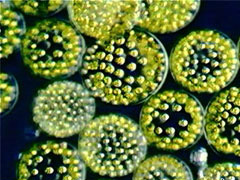Volvox (Protists)
Straddling the plant and animal kingdoms, the protist Volvox forms stunning bright green colonial balls in water bodies that are enriched in nitrates. Found in puddles, ditches, shallow ponds and bogs, Volvox colonies reach up to 50,000 cells and may include daughter and granddaughter colonies.

Volvox Video #1
Spherical colonies of bright green Volvox cells rotate in unison; under oblique illumination with a playing time of 32 seconds. Choose a playback format that matches your connection speed:
Volvox Video #2
A single Volvox colony is seen in more detail, with motion of individual cells probably due to movement of the cells' flagella; under oblique illumination with a playing time of 17 seconds. Choose a playback format that matches your connection speed:
The phylum Chlorophyta (green protists) includes colonial and singular species that help recycle the carbon of aquatic ecosystems, and like plants, can convert carbon dioxide, water and solar energy into carbohydrates and dissolved oxygen. Also in similarity to plants, the chlorophytes, including Volvox, feature cellulose cell walls and chloroplasts. This colonial member of the kingdom Protista can serve as a surrogate in water quality tests for nitrates and other nitrogen-rich dissolved compounds. Worldwide, there are 20 species of Volvox fully described.
The individual cells within the Volvox colony are round and feature a pair of flagella. The colony as a whole, up to 1 millimeter in diameter, can move through the water column, gracefully spinning, while moving their flagella in unison, seeking optimal light for photosynthesis. There is apparently some polarization and differentiation in the colony with cells at the anterior end developing larger stigma or photosensitive eyespots. The spherical green cells cling to a transparent hollow ball of mucilage, forming the Volvox colony. The individual cells in a colonial Volvox resemble Chalmydomonas. However, the colonies have two cell types, somatic and generative. Generative cells subdivide, via mitosis, into small daughter cells. This process continues until a small, bubble-shaped invaginated daughter colony forms within the mucilage matrix of the parent colony. Since the daughter colonies are formed inside out, they must invert prior to release from the parent colony as new independent daughter colonies. In some cases, before release of the daughters, the daughter colonies also undergo asexual reproduction, creating granddaughter colonies within the maternal colony.
Volvox are also capable of sexual reproduction. Some of the generative cells undergo repeated divisions, developing into sperm packets. Research results indicate that these male colonies can produce a pheromone that induces other Volvox colonies in the vicinity to become sexually active. As a unit, the sperm packets are released into the aquatic environment and swim away in search of Volvox eggs. The eggs develop from generative cells, which have not undergone meiosis. After successful fertilization, a resting stage forms which incorporates a thick, spiny cell wall that is often red in color, and that can survive winter temperatures. Within the resting spore, meiosis occurs and each meiospore evolves into a new colony.
